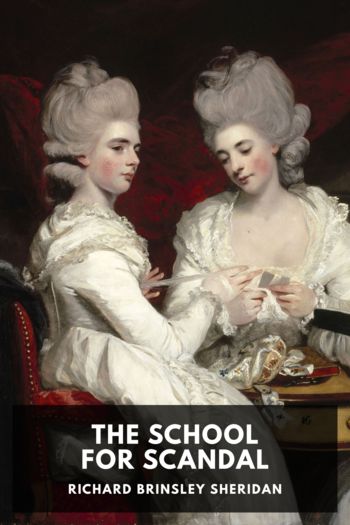The School for Scandal - Richard Brinsley Sheridan (reading strategies book txt) 📗

- Author: Richard Brinsley Sheridan
Book online «The School for Scandal - Richard Brinsley Sheridan (reading strategies book txt) 📗». Author Richard Brinsley Sheridan
Dr. Watkins, in his unnecessary biography of Sheridan, saw fit to insinuate therein that Sheridan was not the real author of the School for Scandal, but that it was the composition of a young lady, daughter of a merchant in Thames Street, who had left it with Sheridan for his judgment as a manager, “soon after which the fair writer, who was then in a state of decline, went to Bristol Hot-Wells, where she died.”
Pope well knew the type to which this Dr. Watkins belonged (“with him most authors steal their works or buy; Garth did not write his own Dispensary”); and the story which Pope crippled, as if by anticipation, Moore readily brought to ground by the publication of the earlier and inchoate suggestions from which Sheridan finally formed the finished play. With the evidence of these growing and gathering fragments before us, we can trace the inception of the idea, and the slow accretion by which it got rounded at last into its present complex symmetry. Moore fills page after page of his life of Sheridan with extracts from the notes and drafts of two distinct plays one containing the machinery of the scandalous college, to have been called possibly the Slanderers, and the other setting before us the Teazles and the Surfaces. This latter was, perhaps, the two-act comedy which Sheridan announced to Mr. Linley in 1775, as being in preparation for the stage. The gradual amalgamation of these two distinct plots, the growth of the happy thought of using the malevolent tittle-tattle of the first play as a background to set off the intrigues of the second, can be clearly traced in the extracts given by Moore. In the eyes of some small critics this revelation of Sheridan’s laborious method of working, this exhibition of the chips of his workshop has had a lowering effect on their opinion of Sheridan’s ability. It is, perhaps, his own fault, for he affected laziness and sought the reputation of an offhand wit. But the School for Scandal is obviously not a spontaneous improvisation. Its symmetrical smoothness and perfect polish cost great labour. It did not spring full armed from the brain of Jove;—Jupiter was a god, and mere mortals must cudgel their poor brains long years to bring forth wisdom. No masterpiece was ever dashed off hurriedly. The power of hard work, and the willingness to take pains, are among the attributes of the highest genius. Balzac had them; he spent the whole of one long winter night on a single sentence. So had Sheridan; he told Ridgeway, to who he had sold the copyright of this very play, and who asked for the manuscript again and again in vain, that he had been for nineteen years endeavouring to satisfy himself with the style of the School for Scandal but had not yet succeeded. A diamond of the first water, like this, is worth careful cutting—and even the chips are of value. Those given to the world by Moore are curious in themselves, independent of their use in disproving the charge of literary larceny preferred by Dr. Watkins.
Since the publication of these extracts, those who seek to discredit Sheridan’s originality have shifted their ground, and content themselves with drawing attention to the singular similarity of Joseph and Charles to Tom Jones and Blifil. They also remark upon the likeness of the scandal-scene to a satirical episode in the Misanthrope of Molière, and on the likeness of Joseph Surface to Tartuffe. Taine, who seems sometimes to speak slightingly of Sheridan, puts this accusation into most effective shape: “Sheridan took two characters from Fielding, Blifil and Tom Jones, two plays of Molière, Le Misanthrope and Tartuffe, and from his puissant materials, condensed with admirable cleverness, he has constructed the most brilliant fireworks imaginable.”
A glance at the play itself will show this to be a most exaggerated statement. The use of Molière and Fielding is far sljghter than alleged; and at most to what does it all amount? But little more than the outline and faint colouring of two characters, and of a very few incidents. While the play could not exist without them, they are far from the most important. Lady Teazle and Sir Peter, the screenscene and the auction-scene—these are what made the success of the School for Scandal, and not what Sheridan may have derived from Fielding and Molière. Nor is this borrowing at all as extensive as it may seem. Joseph is a hypocrite—so is Tartuffe, so is Blifil; but there are hypocrites, and hypocrites, and the resemblance can scarcely be stretched much farther. The rather rustic and—if the word may be risked—vulgar Tom Jones is as unlike as may be to that light and easy gentleman Charles. Yet it seems probable that Sheridan found in Tom Jones the first idea of the contrasted brothers of the School for Scandal. Boaden has even seen the embryonic





Comments (0)